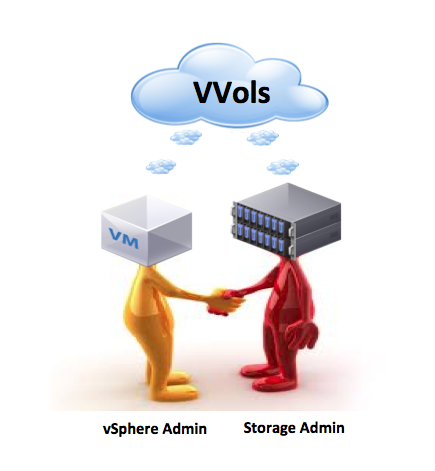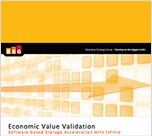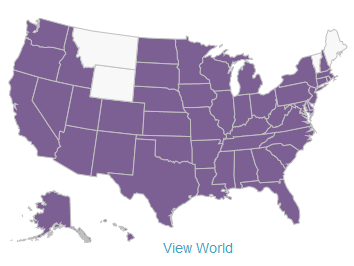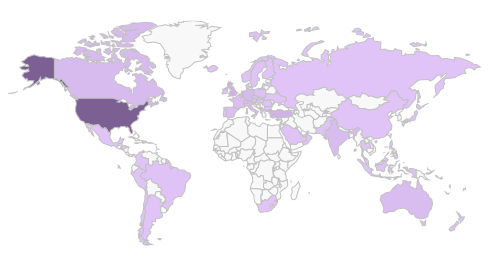Author's posts
Apr 07 2015
So VMware Virtual Volumes (VVols) is here, when will people start using it
After many years in the making VMware’s new storage architecture, Virtual Volumes (VVols) is finally available as part of vSphere 6.0. VVols certainly looks cool but does the old adage hold true, if you build it will they come? In this post I’ll take a look at some reasons why people may want to wait to begin using VVols and some reasons why they might want to start using VVols right now.
Before we begin lets address what VVols is, VMware hasn’t stated this as far as I know but VVols will replace VMFS at some point. VMware never keeps two of any big infrastructure components around as it doubles their development work. They phased out ESX a few years after ESXi was launched, they just killed off their VSA in favor of VSAN and they are still trying to get rid of the vSphere Client in favor of the Web Client, at some point I expect them to phase out the Windows based vCenter Server in favor of the VCSA. So the same will most likely hold true with VVols, at some point VMware will phase out VMFS after it matures and more people start adopting it. Further evidence of this is that VVols is included in every edition of vSphere and it is not an add-on that you only get with certain editions.
Now lets first cover some reasons why you might want to wait before using VVols:
1. No support for storage array replication yet
This is a big one especially for larger enterprises that rely on storage array replication for BC/DR. Storage replication support is not part of the current VASA 2.0 specification so SRM and vMSC are not supported with VVols, for many that’s a show stopper right there. However despite VMware not supporting storage array replication yet some vendor implementations will or do support it now so that could be a workaround but you still can’t use it with SRM or vMSC until VMware builds it into the VASA spec.
2. It’s a 1.0 storage architecture
Yeah it’s been years in the making but it’s still 1.0 and like any 1.0 product there is always growing pains which could cause some people to wait. In addition there is still some feature and compatibility support missing in VVols (i.e. replication) which could prevent some people from adopting it right away. In addition on the storage array side support for it within the array which required a lot of development work from storage vendors is essentially 1.0 as well. A few storage vendors such as HP, NetApp and Dell were design partners and have been developing support for VVols for years so expect them to have the most mature implementations.
3. Not all storage vendors have full support for it yet
There were only a handful of companies (4) that had Day 1 support for VVols in the VMware Hardware Compatibility Guide, expect this to increase as more storage vendors finish their development work and complete the VMware certifications for VVols. In addition storage vendors are still working on broadening their supported features with VVols.
4. Who will win the data center politics game
Remember how it was when you first told your network admins about vSwitches and your networking requirements for vSphere. Yeah they felt they were giving up control and probably put up a fight. The same scenario might play out with VVols, storage admins may not like the fact that they are giving up some control and may push back on it. Resistance has proven to be futile though, the vSphere admins won the networking battle and they will eventually wear down the storage admins as well. To make this easier I encourage you to keep them fully involved, explain what VVols is and how it works and how it will ultimately make their job easier and allow for a much better relationship between VMs and storage.
5. How well does it scale
I have yet to see any performance numbers to show how well VVols does as it scales and a comparison to VMFS. Will it be better than VMFS, the same or worse? I expect it to at least be on par with VMFS, possibly even better, VVols isn’t really about boosting performance over VMFS, it’s about implementing a new VM-centric storage architecture that makes the VM a unit of storage to the storage array. The same held true with RDM’s vs. VMFS, it wasn’t about performance and VMware proved they performed equally as well so I expect the same to hold trued with VVols. It would be nice to have some testing though to back this up and I’ve heard that VMware is working on it.
6. Array features must be licensed
VMware has long tried to mimic storage array features inside of vSphere such as thin provisioning, VM snapshots, Storage vMotion, Storage I/O Control and more. Using many of those features on the vSphere side will not be possible any longer with VVols as everything shifts back to the storage array. So when you take a VM snapshot it will automatically be an array snapshot, same with using thin provisioning, the array will be doing it. This is a good thing as the array is better equipped to handle these functions faster and more efficiently. However this does require you to have those features licensed on your storage array to use them. Some vendors may include these features as part of their core feature set but others may not so check to see how much they will cost.
7. When will the backup vendors get on board
VVols changes the direct to SAN backup model as you now have a Protocol Endpoint and VASA Provider to deal with. I haven’t heard of any backup vendors that support this model with VVols yet but I expect to see support coming soon. Check with your backup vendors to see where they are at with VVol support and what there plans are for it. I expect to see Veeam be one of the first to support VVols as they tend to be ahead of the pack with supporting any new vSphere features.
This may seem like a lot of reasons to discourage you from jumping in and start using VVols but fear not, despite the reasons listed above VVols does provide some great benefits and is the right storage architecture for vSphere. Just like VSAN brings Storage Policy Based Management (SPBM) to the VM-level VVols does the same for shared storage. Aligning VMs directly to storage resources and having the storage array visibility to the VM-level is a very good thing to have. So lets now look at some reasons why you should start using VVols right now:
1. It’s not all or nothing with VVols
You can use VVols right along side of VMFS or NFS and you are not having to completely switch over to VVols all at once. VVols simply becomes another storage option that you can choose to put VMs on. You can easily move VMs from VMFS/NFS to VVols and back using Storage vMotion, so you can setup your Storage Container for VVols and then create or move VMs to it at your own pace.
2. Get early experience with VVols
Where you one of those last few people that made the switch from ESX to ESXi then had to struggle to learn the nuances of ESXi compared to ESX? Are you struggling with learning the vSphere Web Client? Why wait and have to learn how to use VVols when you are forced to do it as you have no other choice. Getting early experience and hands-on with VVols will get you ahead of the game and ensure you are ready when others are struggling to learn about it. You can also serve as a SME for VVols and help others learn it as well.
3. Get your disk space back!
This is big one, remember back in vSphere 5.0 when VMware introduced automatic space reclamation via UNMAP and then was forced to make it a manual process as it was causing some issues. They never did figure out how to make it an automatic process again until now, VVols is the answer. With VVols the storage array is VM-aware and knows when a VM is deleted or moved and can reclaim the disk space that it occupied right away. No more having to running a time and resource intensive process using esxcli to try and reclaim space, it’s automatic with VVols. If that wasn’t good enough on top of that UNMAP commands get passed from the guest OS to the storage array with VVols so you get even more granular space reclamation. This will ensure that you reclaim all capacity possible automatically and give you the best efficiency to maintain the smallest footprint on your storage array.
4. It’s available in all vSphere editions
Anyone can use VVols as long as your storage array supports it, there is nothing extra to license in vSphere. The setup for VVols is fairly easy as well so there is nothing stopping anyone from getting started with VVols right now.
5. Start using Storage Policy Based Management
Don’t get left out, get started using the same SPBM that VSAN users have been enjoying for the last year. SPBM allows you to define storage policies that are aligned to storage array capabilities that provide a whole new level of aligning storage array features and resources directly to VMs. SPBM allows you to pick and choose exactly what a VM should have from a storage perspective and it maintains compliance to ensure that the VM has whatever is defined in the storage policy. This is a powerful capability that VMware has put a lot of development effort in to make sure VMs have the best possible alignment with storage resources and that you can apply storage arrays features on an a la carte basis instead of at the large LUN level on many VMs.
6. Let the storage array do what it does best
The storage array is an I/O engine with software that is written specifically to work with that engine which makes it capable of powerful data movement and manipulation. Using VMFS and vSphere storage features you essentially have a 3rd party telling the array what to do which isn’t the best or most efficient way to do things. By letting the storage array do what it was designed to do without handicapping with a control freak that is pulling all the strings it allows for the array to do what it does best which results in the best possible efficiency. In addition array features are more powerful then comparable vSphere storage features and the array has better visibility into storage resources then vSphere has. As a results features like thin provisioning, snapshots and QoS are all more effective and efficient when done by the storage array.
7. Easier for the IT generalists
VVols ensures that IT generalists that may not have strong storage skills don’t have to be storage admins and can spend most of their time in the vCenter console instead of having to go to the storage console. With SPBM and VVols integration into vCenter you get a single unified management tool for storage that combines the best of both worlds, powerful storage array features managed directly from within vCenter.
8. One architecture to rule them all and in the darkness bind them
File or block? NFS, iSCSI, Fiber Channel, who cares? VVols provides a unified storage architecture across all storage protocols and puts them on a mostly level playing field with vSphere. With VVols you don’t have different types of files systems anymore, VMFS for block and NFS for file, you just have VVols and the various components that are universal to any storage protocol. Yes each protocol will still have some of it sown uniqueness still but VVols helps to eliminate some of that and make the protocol that is used less important.
8. The VM is a unit of storage
Saving the best reason for last, this is what VVols is all about, the storage array now has visibility to see individual VMs. With VMFS we only have visibility from the storage array at the LUN level, we could not see inside it and had no knowledge of the VMs that reside on that VMFS volume. Now with VVols that all changes, the VM is a first class citizen to the storage array and can be treated as a unit of storage. If we want to do an array snapshot on just one VM we can, with VMFS we had to take a snapshot of a whole LUN. If you want to assign QoS policies to certain Tier-1 VMs and not others you can, just about any storage array feature can now be done at the VM-level which is awesome. This eliminates the VMFS silo-ed approach which was wasteful and in-efficient from a storage array perspective. We can now provision storage only as needed without allocating huge chunks of it to VMFS datastores. This is the reason why VMware created VVols to begin with.
Everyone will have their own decision to make on when they want to get started with VVols, keep in mind at some point it will not be “if you will switch to VVols” it will be “when will you switch to VVols”. VVols certainly has some great benefits and better aligns storage resources to individual VMs but you will need to look how they fit into your own environment before making the decision to switch to them. I encourage you to get started as soon as you are able to, because you can use VVols alongside NFS or VMFS it makes the decision much easier as you can slowly dip into the pool instead of jumping all in.
Apr 06 2015
2015 Top 50 vBloggers sign up now to get your gift courtesy of Infinio
Those who made the Top 50 this year get a free commemorative coin courtesy of Infinio. If you made the top 10 you get gold, 11-25 silver and 26-50 copper. Sign up to get it by filling out the form below so I have your shipping info. Since international addresses can be challenging please include any special instructions that I might need to know for shipping.
Apr 05 2015
vBlogger Spotlight: Eric Sloof
Top vBlog 2015 is over but I’m still continuing my vBlogger Spotlight series to shine the spotlight on several prominent bloggers in the community to give you some insight into their experiences with blogging. Today’s spotlight is on Eric Sloof, aka Mr. Scoop due to his keen ability to post news about VMware before anyone else is aware of it. Eric is another one of the OG bloggers as well as Godfather of the Dutch vMafia and also one of the hosts of VMworld TV that broadcasts live from VMworld events. Eric’s blog is NTPro.nl and has consistently been one of the Top 10 blogs. While other bloggers were all getting scooped up by VMware and it’s partners he’s chosen to remain as one of the few very independent bloggers left in the Top 25. Eric is one of the very early VMware Certified Instructors and remains one too this day. So without further ado enjoy a Q&A session with Eric Sloof:
What year did you start your blog?
[Eric] I’ve started my blog nearly 10 years ago. it was September 2005 to be more specific.
What inspired you to start a blog?
[Eric] The inspiration for my blog came from Mike Laverick – He was running the RTFM-Education blog for his own training company and I was really enjoying reading his articles.
Describe your early blogging experiences and how you have evolved over the years?
[Eric] My first blog articles were in Dutch and related to selling Vizioncore vRanger licenses. Back then I was the only reseller in Europe and my blog was used as part of my company ntpro.nl. When Vizioncore was going to an event or I was able to get a new customer, I posted an article about it.
After some time I switched to English and started blogging more about VMware. My first big event was the TSX in Nice 2007. I’ve covered that event with interviews, videos and photo’s. I think back then I was one of the first bloggers who was using multimedia to cover an event. I still have a picture of young Mike and me 🙂
What has kept you blogging over the years and not quitting at it?
[Eric] At the start of 2007 I also became a VMware certified instructor. I kept on blogging because I’ve received a lot of positive feedback from my students and I’ve always used my blog as and extension of the training material. I was able to show an extra demo or screen dumps and dive a little bit deeper than the official material which resulted in good evaluation scores.
After all those years I’m still working as a trainer and I simply can’t quit as long as I experience the enthusiasm of my students.
What was your best experience or fondest memory related to blogging?
[Eric] The best experience because of blogging was being asked as a host for VMworld TV. Me and Jeremy are presenting VMworld TV for tree years in a row now and we’re doing both San Francisco and Barcelona. It’s so great to meet people worldwide who know you from your blog, just incredible. We had a lot of fun recording all the interviews and I felt as a big honour to be part of the VMworld TV crew.
Any advice for others who are new to blogging?
[Eric] My advice for people who are new in blogging is try to be unique. It doesn’t really matter if you’re doing one two or three posts a week as long as you have good content – content is king.
Apr 01 2015
Top vBlog 2015 Full results
So the voting has ended, the results have been tabulated and here they are. There were almost 90 new blogs on the ballot this year and 3 new blogs to make the top 25. This year there was over 2200 votes compared to around 1400 last year. You can read more stats about this years voting here. Voters were asked to pick their top 10 favorite blogs and them rank them from 1 to 10. The votes are weighted so a #1 vote is worth 10 points, a #2 vote is worth 9 points all the way down to a #10 vote being worth 1 point. The total points for each blog were added up to determine the results.
If you missed the live results show be sure and watch the replay of the special Google Hangout awards episode that we recorded with Simon Seagrave, John Troyer and Scott Davis from Infinio as we count up the top 25 winners with lots of color commentary. The vLaunchpad and Planet vSphere-land will be updated soon to reflect the new voting results. Thank you everyone who voted and congratulations to the winners. With so many bloggers out there its a tough scene but I seriously encourage you all to keep at it, the longer you stick with it, the more people notice and will reward you with their vote. You guys are all winners, I know how hard it can be to find the time to blog but do know that your efforts are appreciated and your unselfish dedication makes a difference to a great many of people.
This year any blogger that made the Top 50 will get a special 2″ commemorative coin courtesy of Infinio, I’ll have a form where you can enter your shipping details up in a few days. Bloggers who make the top 10 will get a gold coin, 11-25 a silver coin and 26-50 a copper coin. Also if you’d like a free metal holder for your coin go to this post and re-tweet it. Finally we have another vendor jumping in to get you all a cool metal holder ring with lanyard so you can proudly wear your coin around your neck at VMware events, more details on that soon.
Special thanks to Infinio for sponsoring this year and making the giveaways possible.
Here are the overall voting results…
Here are the full category results…
| Favorite Storage Blog | Votes |
|---|---|
| Cormac Hogan | 458 |
| Virtual Geek (Chad Sakac) | 218 |
| Around the Storage Block (Calvin Zito) | 94 |
| Datacenter Dude (Nick Howell) | 91 |
| Steven Poitras | 91 |
| My Virtual Cloud (Andre Leibovici) | 82 |
| Punching Clouds (Rawlinson) | 79 |
| CloudXC (Josh Odgers) | 69 |
| Pure Storage Guy (Vaughn Stewart) | 60 |
| The Storage Architect (Chris Evans) | 57 |
| Deep Storage (Howard Marks) | 45 |
| StorageIO (Greg Schulz) | 45 |
| Cody Hosterman | 41 |
| 3PAR Dude (Richard Arnold) | 39 |
| Stephen Foskett, Pack Rat | 36 |
| Paul Meehan | 34 |
| Glicks Gray Matter (Neil Glick) | 27 |
| vClouds (Marco Broeken) | 26 |
| A vTexan (Tommy Trogden) | 25 |
| Virtual Valley (Mo Elamin) | 25 |
| Blog.bertello.org (Giuliano Bertello) | 18 |
| Pragmatic IO (Brett Sinclair) | 18 |
| Todd Mace | 18 |
| Vipin V.K. | 17 |
| Wikibon | 17 |
| doOdzZZs Notes (Abdullah Abdullah) | 16 |
| Hus Blog (HDS - Hu Yoshida) | 16 |
| VirtualBoy (Aakash Jacob) | 16 |
| Ray On Storage (Ray Lucchesi) | 14 |
| Why Is The Internet Broken? (J. Parisi) | 14 |
| VI Kernel (Gareth Hogarth) | 13 |
| Jases Place (Jase McCarty) | 12 |
| Keith Norbie Virtual Ideas | 12 |
| Ruptured Monkey (Nigel Poulton) | 12 |
| Penguinpunk.net | 9 |
| Logical Block (Ashish Palekar) | 6 |
| None of these listed here | 256 |
| Favorite Scripting Blog | Votes |
| Virtually Ghetto (William Lam) | 446 |
| LucD (Luc Dekens) | 206 |
| Virtu-al (Alan Renouf) | 194 |
| vCO Team | 118 |
| Steven Poitras | 111 |
| MyVirtuaLife.Net (Andrea Casini) | 67 |
| Dmitrys PowerBlog | 57 |
| vGeek (Kunal Udapi) | 57 |
| Jonathan Medd | 55 |
| Seans IT Blog (Sean Massey) | 51 |
| Double Cloud (Steve Jin) | 45 |
| Blog.bertello.org (Giuliano Bertello) | 41 |
| DBigCloud (Daniel Romero Sanchez) | 39 |
| That Could Be A Problem (Kyle Ruddy) | 35 |
| vTagion (Brian Graf) | 35 |
| Orchestrate This! (Magnus Ullberg) | 34 |
| vNugglets (Allen Crawford) | 24 |
| DefinIT (Sam McGeown/Simon Eady) | 22 |
| Shogan.tech (Sean Duffy) | 21 |
| Steven Kang | 21 |
| Orchestration.io (Chris Green) | 16 |
| Pragmatic IO (Brett Sinclair) | 16 |
| None of these listed here | 417 |
| Favorite Podcast | Votes |
| vBrownBag (Cody Bunch) | 308 |
| VMware Communities Roundtable (Various) | 130 |
| Geek Whispers (Troyer/Brender/Lewis) | 114 |
| Chinwag (Mike Laverick) | 110 |
| Datacenter Dude (Nick Howell) | 102 |
| vSoup (Dearden/Mohn) | 85 |
| StorageIO (Greg Schulz) | 80 |
| In Tech We Trust Podcast (Farley/Poulton/Vanover/Chapman/De Leenheer) | 77 |
| vCatchup (Craig Waters) | 72 |
| Veeam Community Podcast (R. Vanover) | 70 |
| Get Scripting (Various) | 59 |
| vChat (Siebert/Seagrave/Davis) | 54 |
| Virtualization Security (Edward Haletky) | 50 |
| Size Matters (Various) | 48 |
| VUPaaS (Khalsa/Wahl/Atwell) | 46 |
| The CloudCast (A. Delp & B. Gracely) | 38 |
| None of these listed here | 731 |
| Favorite New Blog | Votes |
| vMiss (Melissa Palmer) | 168 |
| VCDX133 (Rene Van Den Bedem) | 134 |
| Emad Younis Blog | 74 |
| CloudFix (Various) | 62 |
| The Virtualist (The Virtualist team) | 58 |
| 3PAR Dude (Richard Arnold) | 49 |
| VirtualBoy (Aakash Jacob) | 42 |
| VCDX Blog (Will Huber) | 41 |
| Settlersoman (Mariusz Kaczorek) | 40 |
| Blog VMware (Leandro Ariel Leonhardt) | 38 |
| CloudManiac (Roman Decker) | 36 |
| DBigCloud (Daniel Romero Sanchez) | 32 |
| Why Is The Internet Broken? (J. Parisi) | 32 |
| VMware Minds (Anjani Kumar) | 31 |
| Steven Kang | 30 |
| vCloudnine (Patrick Terlisten) | 30 |
| V-Desktop (Colas Fabrice) | 29 |
| ITPath (Paolo Torresani) | 28 |
| Virtual Red-dot (Iwan Rahabok) | 28 |
| Virtualization Blog (Shabbir Ahmed) | 28 |
| Nigel Hickey | 27 |
| Imran Qureshi | 25 |
| Pragmatic IO (Brett Sinclair) | 24 |
| RNelson0 (Rob Nelson) | 24 |
| vBuffer (Zlatko Mitev) | 24 |
| vSpace (Parthasarathi) | 24 |
| Route To Cloud (Roie Ben Haim) | 23 |
| The VDI Sage (Kenneth Slish) | 23 |
| VI Kernel (Gareth Hogarth) | 23 |
| Educational Center (Dean Lewis) | 22 |
| VirtualementVotre (Cedric Megroz) | 22 |
| VCDX181 (Marc Huppert) | 18 |
| vZare (Preetam Zare) | 18 |
| Virtual Pharaohs (Shady El-Malatawey) | 17 |
| VM Spot (Matt Bradford) | 16 |
| IT Diversified (Bryan Krausen) | 14 |
| Jose M Hernandez | 12 |
| vmdaemon (Mohammed Salem) | 12 |
| Blog.bertello.org (Giuliano Bertello) | 11 |
| VMZone (Jilesh Kacha) | 11 |
| Great White Technologies (Dave Morera) | 8 |
| MindJudo (Laurens van Gunst) | 7 |
| Kanap.net (Fried Eva) | 6 |
| Virtualis.info (VR Bitman) | 6 |
| None of these listed here | 728 |
| Favorite Independent Blogger | Votes |
| Wahl Network (Chris Wahl) | 234 |
| NTPro.nl (Eric Sloof) | 137 |
| LucD (Luc Dekens) | 68 |
| VMGuru (Various) | 62 |
| ESX Virtualization (Vladan Seget) | 59 |
| VCDX133 (Rene Van Den Bedem) | 58 |
| vNinja (Christian Mohn) | 52 |
| SnowVM Bog (Rene Bos) | 47 |
| The IT Hollow (Eric Shanks) | 42 |
| Seans IT Blog (Sean Massey) | 39 |
| StorageIO (Greg Schulz) | 37 |
| vInfrastructure Blog (Andrew Mauro) | 37 |
| 3PAR Dude (Richard Arnold) | 36 |
| CloudFix (Various) | 36 |
| Settlersoman (Mariusz Kaczorek) | 35 |
| MyVirtuaLife.Net (Andrea Casini) | 32 |
| DBigCloud (Daniel Romero Sanchez) | 31 |
| Viktorious.nl (Viktor van den Berg) | 28 |
| VMFocus (Craig Kilborn) | 28 |
| Virtualization is Life! (Anthony Spiteri) | 27 |
| VMware Front Experience (A. Peetz) | 27 |
| vGeek (Kunal Udapi) | 26 |
| Virtual Valley (Mo Elamin) | 25 |
| mwpreston dot net (Mike Preston) | 24 |
| Come Lo Feci (Pietro Aiolfi) | 22 |
| Perfect Cloud (Rasmus Haslund) | 22 |
| Running-System (Andreas Lesslhumer) | 22 |
| The Saffa Geek (Gregg Robertson) | 22 |
| Virtual Langer (Jason Langer) | 21 |
| WoodITWork (Julian Wood) | 21 |
| Vroom Blog (Fouad El Akkad/Alban Lecorps) | 19 |
| NoLabNoParty (Paolo Valsecchi) | 18 |
| VirtualementVotre (Cedric Megroz) | 18 |
| Mike Tabor | 17 |
| vClouds (Marco Broeken) | 17 |
| RNelson0 (Rob Nelson) | 16 |
| Educational Center (Dean Lewis) | 15 |
| Tims IT Blog (Tim Smith) | 15 |
| Virtually Mike Brown (Mike Brown) | 15 |
| That Could Be A Problem (Kyle Ruddy) | 14 |
| Virtualize Planet (Ricky El-Qasem) | 14 |
| All About Virtualization (Akmal Waheed) | 13 |
| VMware & Veeam Blog (Karel Novak) | 12 |
| Penguinpunk.net | 11 |
| vCloudnine (Patrick Terlisten) | 11 |
| Everything Should Be Virtual (Larry Smith) | 10 |
| Pragmatic IO (Brett Sinclair) | 10 |
| V-Desktop (Colas Fabrice) | 10 |
| The VDI Sage (Kenneth Slish) | 9 |
| Amits Technology Blog (Amit Panchal) | 8 |
| Imran Qureshi | 8 |
| VI Kernel (Gareth Hogarth) | 8 |
| Ather Begs Useful Thoughts (Ather Beg) | 7 |
| DefinIT (Sam McGeown/Simon Eady) | 7 |
| doOdzZZs Notes | 7 |
| IT Diversified (Bryan Krausen) | 7 |
| Uber Tech Geek (Marc Crawford) | 7 |
| VM Spot (Matt Bradford) | 7 |
| Blog.bertello.org (Giuliano Bertello) | 6 |
| Pascals Wereld (Pascal Heldoorn) | 6 |
| vExpertise (F. Lenz/M. Ewald) | 6 |
| Virtual Pharaohs (Shady El-Malatawey) | 6 |
| Virtualization Blog (Shabbir Ahmed) | 6 |
| Show me the Hypervi$or (Matt Heldstab) | 5 |
| VirtualWorldUK (Chris Bell) | 5 |
| Virtual Me (Joseph Griffiths) | 4 |
| VirtualizeMyDC (A. Pogosyan) | 4 |
| Great White Technologies (Dave Morera) | 3 |
| Michael Ryom | 3 |
| Northtech Consulting (Yendis Lambert) | 3 |
| MindJudo (Laurens van Gunst) | 2 |
| None of these listed here | 448 |
| Favorite VDI Blog | Votes |
| Brian Madden | 288 |
| My Virtual Cloud (Andre Leibovici) | 280 |
| IT Blood Pressure (Dwayne Lessner) | 127 |
| Ray Heffer | 87 |
| Virtualize Tips (Brian Suhr) | 87 |
| Seans IT Blog (Sean Massey) | 70 |
| V-Desktop (Colas Fabrice) | 69 |
| My Virtual Vision (Kees Baggerman) | 64 |
| The VDI Sage (Kenneth Slish) | 61 |
| MyVirtuaLife.Net (Andrea Casini) | 58 |
| Imran Qureshi | 53 |
| Glicks Gray Matter (Neil Glick) | 49 |
| Virtualize Planet (Ricky El-Qasem) | 47 |
| Horizon Flux (Tim Arenz) | 43 |
| Virtual Fabric (Chris Beckett) | 40 |
| Blog.bertello.org (Giuliano Bertello) | 34 |
| Come Lo Feci (Pietro Aiolfi) | 30 |
| doOdzZZs Notes | 30 |
| Nigel Hickey | 28 |
| ITuda (Lieven D'hoore) | 24 |
| None of these listed here | 629 |
| Favorite News/Information Website | Votes |
| The Register (Various) | 413 |
| vSphere-land (Eric Siebert) | 260 |
| Petri IT Knowledgebase (Various) | 165 |
| CRN (Various) | 116 |
| Virtualization.Info (Various) | 104 |
| VM Blog (David Marshall) | 98 |
| Wikibon | 95 |
| Tech Targets SearchVMware | 85 |
| InfoWorld (Various) | 80 |
| Virtualization Admin (Various) | 74 |
| Network World (Various) | 62 |
| Cloud Cow (Various) | 57 |
| Virtualization Review (Various) | 50 |
| The Virtualization Practice (Various) | 48 |
| None of these listed here | 484 |
Mar 31 2015
Announcing the Top vBlog 2015 results
Below are the results for the overall voting for the Top 25, full results will be published soon:
And below are the winners of the individual categories:
Mar 30 2015
What Virtual Volumes does not support
VMware finally released the list of supported and non-supported vSphere features and VMware products with their new Virtual Volumes (VVols) storage architecture. I’ve been looking for this in their documentation for VVols and have not found it so I’m glad to see it’s finally available so you can see exactly what is supported and more importantly not-supported that may impact your plans to deploy VVols.
Right now the one non-supported feature that sticks out and is a big one is storage array replication which is not part of the current VASA 2.0 specification. I’m not sure when VMware will support this, hopefully it will be soon as it currently limits VVols adoption. You will probably see storage array vendors supporting this on the array side before VMware supports it through their Storage Policy Based Management (SPBM) in vSphere. Note that while storage array replication is not currently supported vSphere Replication is as it is host based and sits above the VVols architecture. Also note though that while vSphere Replication is supported with VVols, SRM is currently not supported with VVols so it may be of little use to you.
Full-scale adoption of VVols will likely be slow in most shops as they both get experience with the new architecture and VMware along with storage array vendors improve feature support for VVols over time. But one thing to keep in mind when it comes to un-supported features with VVols its not all or nothing with VVols and you can continue to use VMFS right along side VVols to utilize features that currently are not supported such as FT and storage array replication. Also remember every vendors implementation of VVols is different and you should check with them to see what storage array features they support and do not support with VVols.
Below is the list of Not Supported features, expect this to shrink over time, be sure and check out the post on the vSphere blog for more details and the source for this information in the VMware Knowledge Base.
Virtual Volumes (VVols) Not Supported and Interoperable Products and Features
VMware Products
- VMware vRealize Operations Manager 6.x
- VMware vCloud Air
- VMware Site Recovery Manager 5.x to 6.x
- VMware vSphere Data Protection 5.x to 6.x
- VMware Data Recovery 2.x
- VMware vCloud Director 5.x
VMware vSphere 6.0 Features
- Storage I/O Control
- NFS version 4.1
- IPv6
- Storage Distributed Resource Scheduler (SDRS)
- Fault Tolerance (FT)
- SMP-FT
- vSphere API for I/O Filtering (VAIO)
- Array-based replication
- Raw Device Mapping (RDM)
- Microsoft Failover Clustering (MSCS)
Mar 30 2015
And the winners of Top vBlog 2015 are…
…not ready to be revealed yet, you’ll have to wait until tomorrow to find out. I’ve tabulated all the votes and applied points to the votes and have computed the results. We’ll announce the winners on a special live Google Hangout tomorrow with David Davis, Rick Vanover, Simon Seagrave, John Troyer and Scott Davis from Infinio. Go here for information on how you can watch the live results show. While you’re waiting here’s a few tidbits of information on this years voting:
- There were over 2200 votes this year (1400 last year)
- Approximately 32% of the votes were from the US, next highest was 7% from the UK, followed by 6% from the Netherlands, 5% from the Turkey and 4% from Australia and 4% from Germany
- Votes came from all across the US except for Maine, Vermont, Montana and Wyoming (no voting available via pony express)
- We had voters from over 60 different countries including Ukraine, Thailand, Seychelles, Slovakia, Romania, Portugal, Philippines, Peru, Oman, Nigeria, New Caledonia, Malta, Mauritius, Latvia, Iran, Iceland, Egypt, Cyprus, Cote D’Ivoire and Azerbaijan.
- There are 411 blogs in the voting this year, last year there were 320
- There were 7 position changes in the top 10
- There were 4 blogs in the top 25 that were not in there in 2014
- There were 2 blogs that were newcomers this year in the top 25
- There is 1 blog new to the top 10
That’s it for now, tune in tomorrow to see the full results and find out if Duncan can retain the crown for #1 blogger.
Mar 26 2015
Watch the Top vBlog 2015 Results Show Live!
Join the vChat gang, Eric Siebert from vSphere-land, David Davis from Virtualization Software and Simon Seagrave from TechHead along with special guests Scott Davis from Infinio and John Troyer from TechReckoning as we countdown the top 25 bloggers based on the results from my annual VMware/virtualization blog survey. This event will be broadcast live via Google Hangouts at 9:00am PST on Tuesday March 31st right here on vSphere-land.com so bookmark this page, get the popcorn ready and come back when it starts. If you want to tweet about this event please use the hashtag #TopvBlog2015.
Of course all this wouldn’t be possible without the support of our official sponsor of Top vBlog 2015: Infinio













